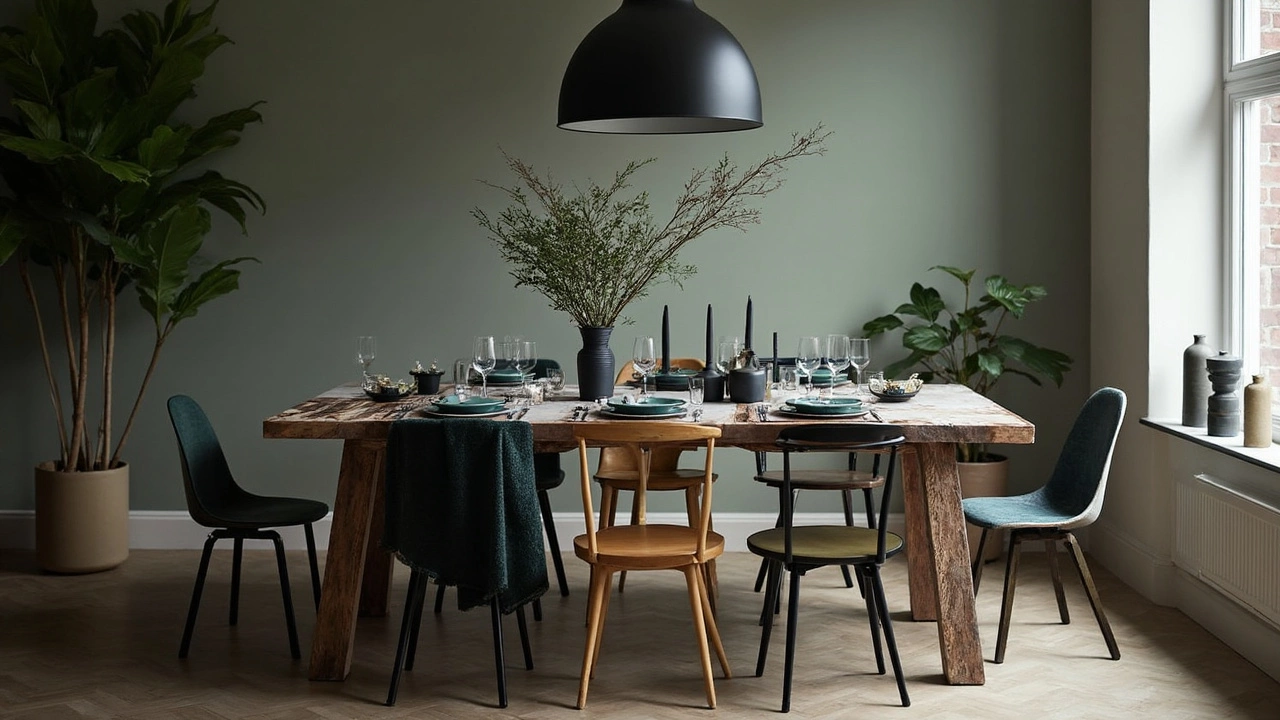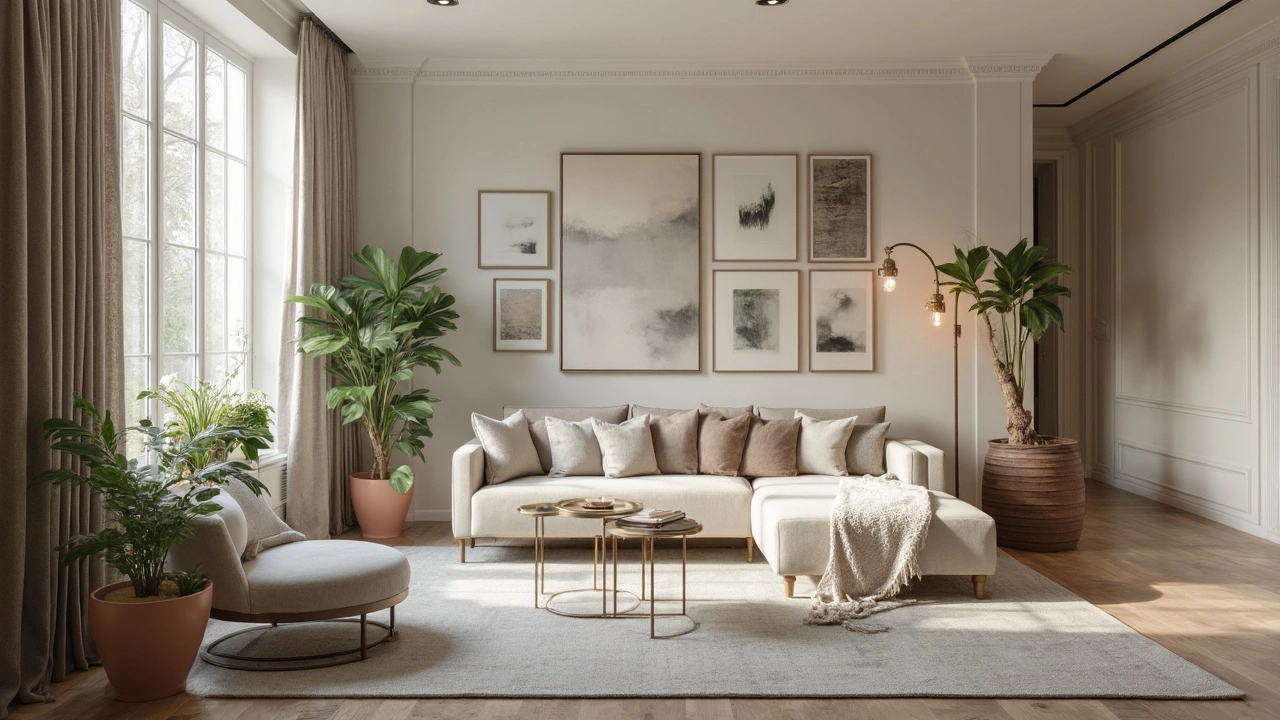If you walk into a pricey-looking house, it rarely feels crowded or overdone. The trick isn't about stuffing every corner with designer stuff—it's about a sharp eye for details that actually matter. Want to give your place that extra punch? Sometimes, just painting your walls a fresh, neutral color can do wonders. Creamy whites, warm grays, or soft taupes make rooms look bigger and more upscale. Avoid bright, dated colors. A can of paint can be your cheapest ticket to making a space look fancier than it is.
Now, look around at your lighting. Still stuck on one sad ceiling fixture? Swap it for a modern chandelier or layered lighting with table and floor lamps. Warm, soft bulbs always feel richer than cold fluorescent ones. Think of light as makeup for your home—mixing a few different sources is way more flattering than relying on just one overhead glare. Even budget-friendly lighting upgrades can leave guests thinking you spent way more than you did.
- Spot-On Color Choices
- Lighting Makes All the Difference
- Smart Upgrades & Finishes
- Declutter and Style Like a Pro
Spot-On Color Choices
Choosing the right paint colors is one of the fastest ways to make your home look expensive. Interior designers almost always start with a neutral palette because it creates a calm, upscale vibe—think creamy white, soft grey, and subtle beige. These shades make rooms look bigger and brighter, and they work with pretty much any furniture or style you try later on.
If you want proof: popular luxury homes almost never use harsh primaries or muddy, outdated tones on big surfaces. Painting trim, doors, or even the ceiling a crisp white (like Benjamin Moore’s Chantilly Lace or Sherwin Williams’ Pure White) can give your home that designer-finished touch. If you’re craving some color, deep blues, charcoal, and earthy greens can add an expensive feel, especially in smaller doses like powder rooms or accent walls.
- Stick to no more than three main colors in a room—any more and it starts to look chaotic.
- Use different shades of your chosen color for an easy layered look.
- Flat or eggshell finishes look more modern and high-end than glossy ones.
Here’s a little hack: match your wall color to your drapes for a seamless, custom feel. The pro trick is consistency; repeating colors from one room to another ties the whole place together and makes your home look thoughtfully designed—not random. Getting these expensive looks doesn't mean buying a ton of paint, just picking wisely so every room flows with the next.
Lighting Makes All the Difference
Let’s get real—a single overhead light can make your room feel flat, cheap, and dated. Most modern homes that look expensive actually use three types of lighting: ambient, task, and accent. It’s not just about making the room brighter; it’s about adding layers and depth. That’s why designers always say lighting is like jewelry for your home.
Try mixing things up. Install a dimmer on your main lights, so you control the mood. Swap out builder-basic fixtures for affordable knockoffs of high-end designs; stores like IKEA, Wayfair, and even Home Depot have surprisingly sleek options. And don’t be afraid of a stand-out piece—like a sculptural floor lamp or a bold pendant over your dining table. It’s a small detail, but it gives your space that designer edge.
Save the harsh white bulbs for the garage. In your living spaces, stick to warm white LEDs (2700K or 3000K). They’re energy efficient and instantly make your rooms feel welcoming and upscale. To get that expensive vibe, use at least two or three light sources per room: a ceiling lamp, a table or floor lamp, and maybe an LED strip under a shelf or cabinet. You’ll be shocked how everything suddenly glows and looks more polished.
- Add mirrors across from windows to bounce natural light deeper into the space.
- If you have art, light it up with easy-to-install picture lights or small spotlights. It turns a $10 print into something that feels like gallery art.
- Don’t forget about cozy spots: fairy lights in a glass jar, battery-operated candles on shelves, or under-cabinet lights in the kitchen all work in a pinch.
Little lighting upgrades like these can make even a simple house look intentional and sophisticated, without a big hit to your wallet.

Smart Upgrades & Finishes
Small changes can make a world of difference when it comes to making your space look more expensive. Start by swapping builder-grade hardware for sleek handles, pulls, and faucets. Matte black, brushed gold, and nickel are all popular right now and look serious without a high price tag. Cabinet hardware and bathroom fixtures are easy upgrades you can do yourself in an afternoon.
If your floors are outdated, consider luxury vinyl plank or laminate. These options look strikingly like real wood or stone, but don’t cost nearly as much. Area rugs in living spaces also pull a room together and can hide less-than-perfect floors. Stick to simple patterns and neutral colors for a modern vibe.
You don’t need marble countertops to get that luxury look—many modern laminates and quartz options bring style and durability for way less cash. And if you’re updating your backsplash, peel-and-stick tiles are a real gamechanger for renters or anyone who wants a fast upgrade without hiring a pro.
- Switch out light switch plates and outlet covers for clean, modern designs. Old, yellowed plastic instantly makes a place feel tired.
- Paint interior doors a high-contrast color or use bold hardware to add interest.
- Upgrade bedding and sofa covers to thicker, textured fabrics. They look and feel more plush.
- If you have built-in shelves, add lighting underneath for a subtle glow—this trick is all over high-end homes.
It’s all about picking a few standout details. When you focus on visible spots guests notice, your expensive home decor vibe comes through loud and clear—even if you didn’t drop a fortune to get it there.
Declutter and Style Like a Pro
The most expensive-looking homes are more about what you get rid of than what you bring in. Cluttered shelves, tangles of cords, or a jumble of mismatched items can drag down the whole vibe. Clearing surfaces immediately makes any room appear bigger and more put-together. A 2023 survey by the National Association of Realtors found that 95% of real estate agents said decluttering is the easiest way to boost a home's appeal quickly.
Start by clearing counters and tables. Ditch old magazines, cups, or stuff you barely notice anymore. Try this: gather everything from a room onto the floor, then only put back what you love or actually use. Donate or toss the rest. It’s simple, but most people skip this basic step.
- Group decor in odd numbers—like three vases together—so it looks intentional.
- Keep bookshelves neat: stack books by size or color, with a few empty spaces left on each shelf.
- Hide cables behind furniture or use cord covers. Nothing screams "messy" like a web of wires.
- Limit your surfaces to one or two standout pieces—maybe a bold vase or tray. Let them breathe.
Once you remove the noise, add a few smart touches. Plants are a simple hack—real or convincing fakes can lift the whole look. Layer in modern accent pillows, a stylish throw, or a stack of pretty books. Here’s a trick: big art on the wall usually feels more expensive than lots of little knick-knacks. If large pieces aren’t in your budget, try a DIY framed print or poster in a sleek frame.
Good styling isn’t about buying more. It’s about being picky and thoughtful about what stays—and giving every piece a reason to be in your space. Less stuff, arranged with purpose, lets the right things stand out.


